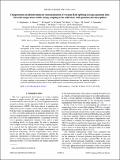Files in this item
Compensation of phonon-induced renormalization of vacuum Rabi splitting in large quantum dots : towards temperature-stable strong coupling in the solid state with quantum dot-micropillars
Item metadata
| dc.contributor.author | Hopfmann, C. | |
| dc.contributor.author | Musiał, A | |
| dc.contributor.author | Strauss, M. | |
| dc.contributor.author | Barth, A. M. | |
| dc.contributor.author | Glässl, M. | |
| dc.contributor.author | Vagov, A. | |
| dc.contributor.author | Strauss, M. | |
| dc.contributor.author | Schneider, C. | |
| dc.contributor.author | Hoefling, Sven | |
| dc.contributor.author | Kamp, M. | |
| dc.contributor.author | Axt, V. M. | |
| dc.contributor.author | Reitzenstein, S. | |
| dc.date.accessioned | 2016-02-12T10:40:14Z | |
| dc.date.available | 2016-02-12T10:40:14Z | |
| dc.date.issued | 2015-12-03 | |
| dc.identifier | 240791695 | |
| dc.identifier | 053aab9e-fafc-4b96-bfdb-672a023353b2 | |
| dc.identifier | 84952705336 | |
| dc.identifier | 000365779600005 | |
| dc.identifier.citation | Hopfmann , C , Musiał , A , Strauss , M , Barth , A M , Glässl , M , Vagov , A , Strauss , M , Schneider , C , Hoefling , S , Kamp , M , Axt , V M & Reitzenstein , S 2015 , ' Compensation of phonon-induced renormalization of vacuum Rabi splitting in large quantum dots : towards temperature-stable strong coupling in the solid state with quantum dot-micropillars ' , Physical Review. B, Condensed matter and materials physics , vol. 92 , no. 24 , 245403 . https://doi.org/10.1103/PhysRevB.92.245403 | en |
| dc.identifier.issn | 1098-0121 | |
| dc.identifier.uri | https://hdl.handle.net/10023/8211 | |
| dc.description | The authors acknowledge financial support from Deutsche Forschungsgemeinschaft (DFG) via projects AX17/7-1 and RE2974/5-1. | en |
| dc.description.abstract | We study experimentally the influence of temperature on the emission characteristics of quantum dot-micropillars in the strong coupling regime of cavity quantum electrodynamics (cQED). In particular, we investigate its impact on the vacuum Rabi splitting (VRS) and we address the important question of the temperature stability of the coherent coupling regime in a semiconductor system, which is relevant in view of both fundamental study and future applications. To study the temperature dependence we investigate an unprecedentedly large number of strong coupling cases (89) in a wide temperature range from 10 up to 50 K, which constitutes a good basis for statistical analysis. The experiment indicates a statistically significant increase of the VRS with temperature in contrast to an expected decrease of the VRS due to the dephasing induced by acoustic phonons. From the theoretical point of view, the phonon-induced renormalization of the VRS is calculated using a real-time path-integral approach for strongly confined quantum dots (QDs), which allows for a numerical exact treatment of the coupling between the QD and a continuum of longitudinal acoustic phonons. The absence of the expected decrease of the VRS with temperature in our experimental data can be attributed to a unique optical property of laterally extended In0.4Ga0.6As QDs used in this study. Their electronic structure facilitates an effective temperature-driven increase of the oscillator strength of the excitonic state by up to 40% in the given temperature range. This leads to enhanced light-matter interaction and overcompensates the phonon-related decrease of the VRS. The observed persistence of strong coupling in the presence of phonon-induced decoherence demonstrates the appealing possibility to counteract detrimental phonon effects in the cQED regime via engineering the electronic structure of QDs. | |
| dc.format.extent | 10 | |
| dc.format.extent | 565803 | |
| dc.language.iso | eng | |
| dc.relation.ispartof | Physical Review. B, Condensed matter and materials physics | en |
| dc.subject | QC Physics | en |
| dc.subject | NDAS | en |
| dc.subject.lcc | QC | en |
| dc.title | Compensation of phonon-induced renormalization of vacuum Rabi splitting in large quantum dots : towards temperature-stable strong coupling in the solid state with quantum dot-micropillars | en |
| dc.type | Journal article | en |
| dc.contributor.institution | University of St Andrews. School of Physics and Astronomy | en |
| dc.contributor.institution | University of St Andrews. Condensed Matter Physics | en |
| dc.identifier.doi | 10.1103/PhysRevB.92.245403 | |
| dc.description.status | Peer reviewed | en |
This item appears in the following Collection(s)
Items in the St Andrews Research Repository are protected by copyright, with all rights reserved, unless otherwise indicated.

